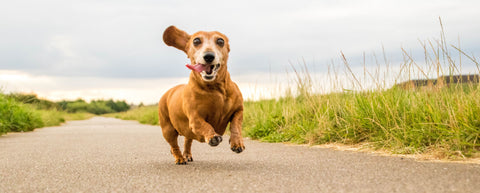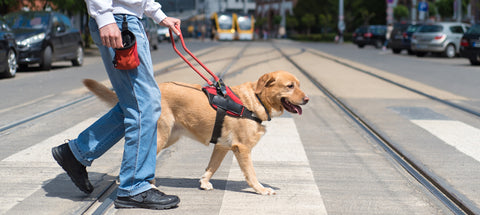If you live in a house with stairs, the chances are that the sound of your dog pounding up and down them will be familiar.
As a general rule, it’s better not to let your canine pal have the run of the stairs. However, as dog owners ourselves, we know that it’s inevitable that they will sometimes find a reason to climb up and down.
What goes up…
When you go upstairs, your dog may well trail behind you, just to make sure you don’t go out of sight. They might rush upstairs to find their favorite person or grab a precious toy. Or they might sneak up the stairs to reclaim a human bed as a dog’s bed which, according to their doggy brain, is their ancestral right. Besides, if they don’t test the bed for you, how will you ever know if it’s comfortable enough for humans?
… must come down
When your dog rushes down the stairs, half the time it will be a race to the door triggered by the doorbell. Or perhaps you’ve opened the fridge (aka the ‘magic cupboard’), raising their hopes that it’s dinner time. Or maybe you’ve done something to suggest that a walk could be just about to happen – e.g. you’ve picked up your keys, put on your coat or opened the door.
Investigating the ups and downs
Whatever the reason for going up or coming down the stairs, could it be harmful for your dog? Here are some of the considerations to take into account.
Carpet vs wood

The first point to think about is what kind of material is under your dog’s paws as they race up and down the stairs. Any kind of carpet will provide considerably more traction than bare wood, which can be pretty slippery for a dog, especially if they have long, untrimmed nails.
The same goes for wooden floors. We talk about this in our blog on how to adapt your home for your senior dog, where we recommend putting down non-slip mats to give your dog a more secure surface to walk across.
If you have bare wooden stairs, you could make life easier for your dog by carpeting your stairs. You can even get pet-friendly non-slip stair treads which stick onto wooden stairs and give your dog extra traction as they go up and down, helping to prevent them from slipping.
Which breeds do best on stairs?
Breed also comes into play when you’re thinking about how easily your dog will manage the stairs.
It’s obvious that a rangy, long-legged Lurcher is going to find it simpler to bound up the stairs than a little low-rider like a Chihuahua or a Yorkshire Terrier. Dogs that have extra-long backs, such as Dachshunds, Corgis and Bassett Hounds, should also avoid taking the stairs.
Dogs that are scared of stairs
Another factor to consider is that some dogs are scared of stairs. Technically, this is called ‘bathmophobia’. It comes from the Greek for step – ‘bathmos’ - and fear – ‘phobia’.
Dogs can develop a fear of stairs if they’re not used to them, perhaps because they’ve grown up in a Craftsman-style home. Alternatively, a dog who’s previously had a bad experience on some stairs might develop bathmophobia.
Either way, you can help your dog to overcome this fear by being patient, rewarding them for coming near the stairs, and helping them to see that there’s nothing to be scared of.
Young dogs and stairs
From your young dog’s point of view, your stairs are a mountain to climb. They can also represent a real hazard. Veterinarians suggest that young dogs should only be allowed on the stairs after the age of 12 weeks – and even then, they should be closely supervised.
With some large breeds, such as Labradors and Retrievers, it’s advisable to wait even longer. If in doubt, ask your vet for advice and fit a stair gate at the bottom of the stairs.
If your dog is a portable size, sometimes the best solution is for you to simply carry them up the stairs. See our blog for tips on how to lift your dog safely.
Be proactive with your dog's joints
Dogs that are prone to stiffness
When your dog is going up and down stairs, it does require a greater range of motion in the front and back joints, compared to when they’re strolling along on flat ground.
And if your dog is getting older and showing signs of stiffness, going up and down stairs can put extra pressure on their joints. In this case, a stair gate can be a good idea to stop your furry best friend from following you up the stairs.
You might also consider using a ramp if your dog has difficulty walking up indoor or outdoor steps. You can buy one ready-made, or do a quick online search and you’ll find all kinds of ingenious solutions.
Does your dog do stairs?
If your dog doesn’t do stairs, it’s probably not because they’re being a diva. It’s more likely that they have stiff joints. As well as the approaches we suggest here, we recommend trying your pup on YuMOVE, which contains scientifically proven ingredients to soothe stiff joints. And in the meantime, if you’ve tried your hand at a home-made ramp, please share the pictures with us on Facebook and Instagram.










